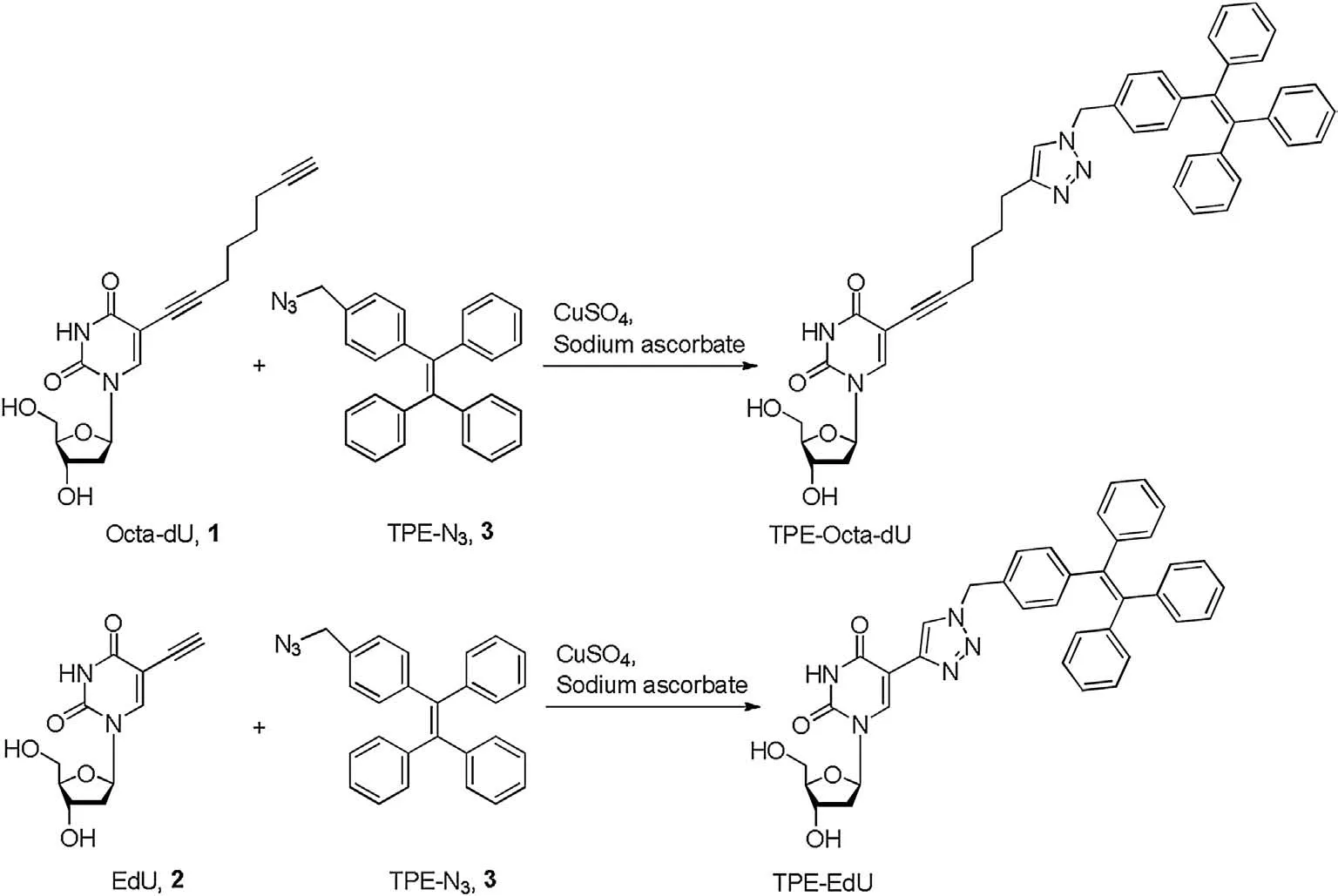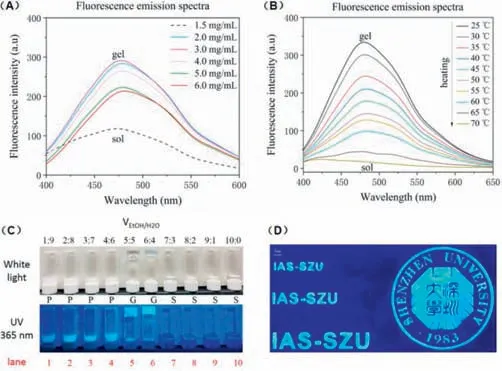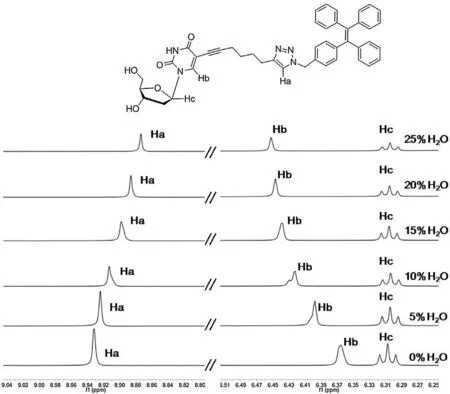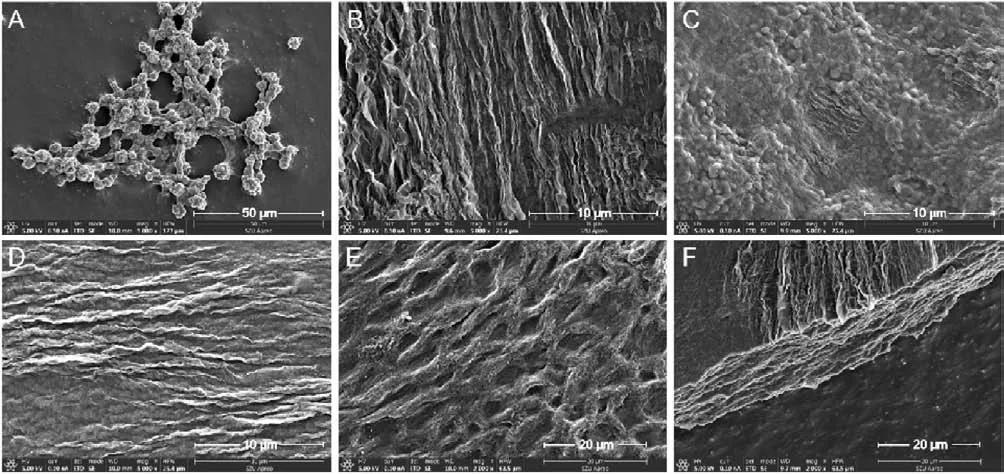Intermolecular hydrogen-bond interaction to promote thermoreversible 2'-deoxyuridine-based AIE-organogels
2021-10-14XuanZhaoLongZhaoQiuyunXiaoHaiXiong
Xuan Zhao,Long Zhao,Qiuyun Xiao,Hai Xiong*
Institute for Advanced Study, Shenzhen University, Shenzhen 518060, China
ABSTRACT Fluorescent supramolecular nucleoside-based organogels or hydrogels have attracted increasing attention owing to their tunable stability,drug delivery,tissue engineering,and inherent biocompatibility for applications in designing sensors.As the temperature of a constant TPE-Octa-dU gelator at MGC as low as 0.2 wt% was increased with gel to sol transition, a progressive decrease in the fluorescence intensity was observed.1H NMR study in ethanol-d6/H2O revealed the existence of intermolecular hydrogen-bond interaction between uridine nucleobase and triazole moieties.Based on these experiments, thus organogels induced by hydrogen bonding can promote an aggregation-induced emission (AIE) of TPE moiety.Thermoreversible gelation properties have been investigated systematically, including AIE-shapemorphing architecture owing to their unique solid-liquid interface and easy processability.At the same line,the related TPE-EdU derivative which was synthesized from 5-ethynyl-2'-deoxyuridine does not deliver organogels or hydrogels,and under similar circumstances TPE moiety of TPE-EdU does not efficiently exhibit AIE phenomenon either.
Keywords:Supramolecular Organogel Aggregation-induced emission Nucleoside Click chemistry
Supramolecular nucleoside-based organogels or hydrogels formed by the self-assembly of low molecular-weight nucleoside moieties have attracted considerable interest due to their tunable stability and inherent biocompatibility for applications in designing sensors, drug delivery or tissue engineering [1-3].To achieve gelation, there must be a balance between the tendency of the small molecules to dissolve or to aggregate.The development of 2'-deoxyuridine derivatives with hydrophobic moieties has been a long history as low molecular-weight organogels or hydrogels since Kim group reported [4,5].Physicochemical studies (differential scanning calorimeter,small-angle X-ray scattering,FT-IR,CD spectroscopies, transmission or scanning electron microscopy)have showed spontaneous assembling of supramolecular structures including vesicles, fibers, hydrogels, and organogels [4-9].Moreover,guanosine-quarter-based supramolecular hydrogels are usually stabilized by K+or other alkali metal cations.Thus, the effect of various parameters (concentration, nature of metal ion,and temperature)on the properties of this gel is also reported[10-13].Furthermore, as a smart soft material, self-healing supramolecular nucleoside hydrogels with photoluminescent property have attracted much attention in the biomedical fields(biological imaging,drug delivery and biosensors)and in engineering research(optical switch, pH sensors and thermal sensors) [14-16].
In 2001,Tang et al.found aggregation-induced emission(AIE)of 1-methyl-1,2,3,4,5-pentaphenylsilole in the condensed state,which is opposite to the classic aggregation-caused quenching(ACQ) indicating a nonemissive fluorogen in a dilute solution is induced to emit efficiently by aggregate formation [17].Then onwards, the second generation AIE bearing tetraphenylethene(TPE) derivatives with specific analyte binding have been developed and showed advantage of the AIE effect on applications as chemical sensors, biological probes and biomedical studies [18-25].Further, Tang et al.reported an entire gelation process of chitosan in LiOH-urea aqueous system can be visualized by AIE fluorescent imaging [26].
Copper catalyzed “click” reaction has also been applied to the functionalization of nucleoside and oligonucleotide in our previous work[27-31].Herein,different from Tang group’s work of aminoyne “click” polymerization [32-34], we established a novel selfassembly system of TPE-Octa-dU by using 5-(octa-1,7-diynyl)-2'-deoxyuridine(Octa-dU,1)and azido TPE(TPE-N3,3)via the“click”reaction (Scheme 1, Tables S1, S2 and Figs.S4-S16 in Supporting information).The supramolecular AIE-organogels based on TPEOcta-dU with water-resisting are formed in 5:5 mixed ethanol/water due to the cross-linking of their monovalent polyvalent networks.As comparison,higher hydrophilic TPE-EdU derivativing from 5-ethynyl-2'-deoxyuridine (EdU, 2) did not form organogels or hydrogels in any of the tested solvents.To the best of our knowledge, a very few studies have reported on AIE-nucleoside organogels of TPE moiety.The nucleoside-based organogels as a template for the preparation of shape-controlled nanofibers or nanomaterials will be investigated in future study,and metal ionmediated supramolecular hydrogels based on TPE-Octa-dU analogues will also be developed in molecular luminescence or biosensors [35,36].

Scheme 1.Synthesis of TPE-Octa-dU and TPE-EdU via the copper(I)-catalyzed “click” reaction.
The gelation ability was determined by inverted vial method[37].The gelation capacity was found to depend on the alkyl chain length and the hydrophilic five-ring triazole moiety.TPE-EdU containing shorter hydrocarbon chains(ethynyl)did not yield gels in any of the solvents tested.The organogels can be formed rapidly when TPE-Octa-dU bearing longer chains (octadiynyl) were dissolved in a mixture of organic solvents by heating, and then cooled down to room temperature.As shown in Table S3(Supporting information), the TPE-Octa-dU dissolved in a series of individual or mixed solvents displays quite different gelation properties, forming the best stable organogels at minimum gelation concentration (MGC) as low as 0.2 wt% in a 5:5 ratio of mixed VEtOH/H2O(Fig.1).Furthermore, stable opaque organogels can also be formed in 5:5 ratio of mixed VMeOH/H2Oor VAcetone/H2Oat concentrations as low as 0.3-0.4 wt% (Fig.S1 in Supporting information).The best organogels was found to be stable for several months at r.t.The gelation capacity depends on the chain length and polarity of TPE-Octa-dU and TPE-EdU.Thermoreversible gel-sol phase transition temperature (Tgel) was investigated using water-bath heating.The gel-sol interconversion was found to be thermo reversible over several cycles of heating and cooling steps, and the organogels were stable for months at r.t.Other common mixture organic solvents and water did not support gelation process even at high concentrations of TPE-Octa-dU.The Tgelvalue of TPE-Octa-dU dissolved in 5:5 ratio of mixed VEtOH/H2Ois 61。C,which is significantly higher than that observed in 5:5 ratio of mixed VMeOH/H2O(55 。C) or VAcetone/H2O(52 。C).

Fig.1.Fluorescence spectra of TPE-Octa-dU with increasing(A)concentrations and(B) temperature; sol = solution; (C) Photoluminescence spectra in the form of solution or organogels in mixed ethanol and water.Top: Photography of samples.Bottom:same samples under ultraviolet illumination;(D)Fluorescence imaging of gels on PMMA plate with microporous scales.
Natural purine and pyrimidine nucleosides are virtually nonfluorescent and show short excited-state decay time, while self-assembling organic fluorophores including rigid nucleolipids that retain or exhibit enhanced fluorescence upon aggregation are promising candidates for fabricating optical materials and sensors[38,39].In addition to the fluorescent study, as we expected,solutions of TPE-Octa-dU are virtually non-fluorescent,and its gel state with various concentrations shows strong fluorescence at the excitation of 375 nm and emission of 478 nm in appropriate ratio of mixed VEtOH/H2O(Fig.1A).Interestingly,as the temperature of gels of TPE-Octa-dU was increased from 25 。C to 70 。C, a progressive decrease in the fluorescence intensity was observed(Fig.1B).This effect was found to be significantly reversed as hot solutions were gradually cooled to room temperature to form gels.For comparison,TPE-Octa-dU in the form of solution or gelation within various ratios of ethanol and water was photographed under the white light and UV lamp, respectively.The samples under ultraviolet illumination (365 nm) indicated that TPE-Octa-dU retain their fluorescence upon AIE (Fig.1C).The results are agreed with the previous studies have revealed that the restriction of intramolecular rotations(RIR)in the aggregates is the main cause for the AIE process [26].
Encouraged by these exciting results,we systematically studied this kind of TPE-Octa-dU organogels by inverted fluorescent microscope.In this study, the extremely dilute solution of TPEOcta-dU with 0.2 wt% was performed to form organogels and further treated by drying procedure.The image of the solution showed no specific patterns.Furthermore, the gelation provides AIE-shape morphing architecture owing to their unique solidliquid interface and easy process ability.The PMMA plate with microporous scales from approximately 0.5 mm to 2.5 mm exhibited bright blue fluorescence under ultraviolet illumination(365 nm),which indicated this kind of organogels maintains their characterization of soft matter and fluorescence AIE (Fig.1D).Further, the bright stable pattern being with reticular structure was also observed in xerogels state by using the inverted fluorescent microscope (Fig.S3 in Supporting information).
Further, the viscoelastic properties of organogels were studied by performing rheological measurements.The storage modulus(G’) and loss modulus (G’’) of TPE-Octa-dU in mixture solvents were monitored as a function of oscillating frequency at constant strain.The higher value of G’ than G’’ at frequencies of 1-50 Hz indicates that Gel-1 (in VEtOH/H2O=5:5) displays a solid-like behavior in this frequency range, but it is much more liquid-like(G’’ >G’) at a higher frequency (Fig.2) [40].Compared to Gel-2(VMeOH/H2O= 5:5) and Gel-3 (VAcetone/H2O= 5:5), the crosslink of storage and loss modulus of Gel-1 is much higher(400 Pa for Gel-1 at a frequency of 50 Hz,300 Pa and 50 Hz for Gel-2,260 Pa for Gel-3 at 45 Hz),which shows that Gel-1 is much more stable than those of other two.The result is in agreement with those of gel-sol phase transition temperature (Tgel).

Fig.2.Evolution of G’ and G’’ of TPE-Octa-dU at the concentration as low as 0.2 wt% was monitored as a constant of strain at different oscillating frequency.(A) Gel-1,VEtOH/H2O=5:5; (B) Gel-2, VMeOH/H2O = 5:5; (C) Gel-3, VAcetone/H2O = 5:5.
To obtain further information on the intermolecular hydrogen bonding interaction between uridine or triazole moieties, we measured the1H NMR spectra of TPE-Octa-dU in EtOH-d6containing various amounts of H2O.With increasing H2O content,the chemical shifts of triazole-Ha shift to high field and that of pyrimidine-Hb is reverse (Fig.3).Addition of 20% H2O content, a temperature varied1H NMR experiment was further performed to prove the intermolecular hydrogen bonding interaction or the π-π stacking between the triazole and the aromatic ring of TPE.With increasing temperature from 25 。C to 60 。C, the intermolecular hydrogen bonding is decreasing,and both of the chemical shifts of triazole-Ha and pyrimidine-Hb shift to high field(Fig.S15).On the other hand,the chemical shift of the ribose-Hc is not obvious(Fig.3 and Fig.S15).The addition of 25% H2O content, TPE-Octa-dU molecules self-assemble and intermolecular hydrogen bonding interaction probably further enhances.For up to about 30% H2O content, TPE-Octa-dU will form organogels completely, without NMR signals.

Fig.3.1H NMR spectra of TPE-Octa-dU in EtOH-d6 containing various ratios of H2O.
To gain insight into the microstructure of organogels,scanning electron microscopy(SEM)analysis was performed on xerogels or lyophilized samples.TPE-Octa-dU dissolved in mixing ethanol and water, and the effect of TPE-Octa-dU in the form of solution and organogels or precipitation was studied.In the case of TPE-Octa-dU dissolving in ethanol and water (v/v=7:3, the solution state), the aggregation cluster can be found in Fig.4A.Decreasing the ratio of ethanol and water(v/v=5:5,the gel state),regular pattern with the sheet substructures is shown in Fig.4B.Further, aggregation cluster will be predominated in Fig.4C(v/v=4:6,the precipitation state).Further, the effect of the protonized solvent was explored.Using similar methanol as mixture organic solvent, regular sheet substructures is shown in Fig.4D.As comparisons,using acetone as non-protonized solvent, the mesh pattern can be founded in Fig.4E.The hierarchical sponge-like structures can be seen in all cases of TPE-Octa-dU xerogels dried from Gel-1 (Fig.4F).These results show that interactions of TPE-Octa-dU molecule are depends upon its solubility and the ambient protonized solvent.Except for the π-π stacking between the triazole and the aromatic ring of TPE, we supposed that hydrogen-bonding interactions of nucleoside are also dominant for driving gelation process.All above samples were treated by drying procedure.Finally, as showed in Fig.4, xerogels exhibit hierarchical three-dimensional sponge-like structures with a thickness of approximately 5 μm,and on their surfaces there shows a regular pattern of the sheet or mesh substructures.

Fig.4.SEM images of TPE-Octa-dU xerogels at the concentration as low as 0.2 wt%.(A)Ethanol and water(v/v=7:3);(B)Ethanol and water(v/v=5:5);(C)Ethanol and water (v/v=4:6); (D) Methanol and water (v/v=5:5); (E) Acetone and water(v/v=5:5); (F) The hierarchical sponge-like structures, ethanol and water (v/v=5:5).
To our knowledge, this work is the first example of AIE organogels based on 2'-deoxyuridine conjugating tetraphenylethene.Except for the π-π stacking between the triazole and the aromatic ring of TPE, hydrogen-bonding interactions of modified nucleosides are also demonstrated to be dominant for promoting gelation process.It directly reveals that AIE process is caused in their gelation aggregate.This kind of nucleoside-based organogels or its xerogels maintains their characterization of soft matter and fluorescence AIE, which can be applied in fluorescent 2D barcode symbols and 3D printing.Furthermore, the biocompatibility and safety of chiral TPE-Octa-dU analogues are being investigated by cell culture assay with potential applications in cell imaging,drug delivery system or tissue engineering.
Declaration of competing interest
The authors report no declarations of interest.
Acknowledgment
This work is supported by the Science and Technology Innovation Commission of Shenzhen, China (Nos.KQJSCX20180328095517269 and JCYJ20170818143131729).
Appendix A.Supplementary data
Supplementary material related to this article can be found, in the online version,at doi:https://doi.org/10.1016/j.cclet.2020.10.008.
杂志排行
Chinese Chemical Letters的其它文章
- D-A-D structured selenadiazolesbenzothiadiazole-based near-infrared dye for enhanced photoacoustic imaging and photothermal cancer therapy
- Synthesis and biological evaluation of a lipopeptide-based methamphetamine vaccine
- Nucleic acids induced peptide-based AIE nanoparticles for fast cell imaging
- Titanate nanofibers reduce Kruppel-like factor 2(KLF2)-eNOS pathway in endothelial monolayer: A transcriptomic study
- Drug-induced hierarchical self-assembly of poly(amino acid) for efficient intracellular drug delivery
- Co-delivery of anticancer drugs and cell penetrating peptides for improved cancer therapy
